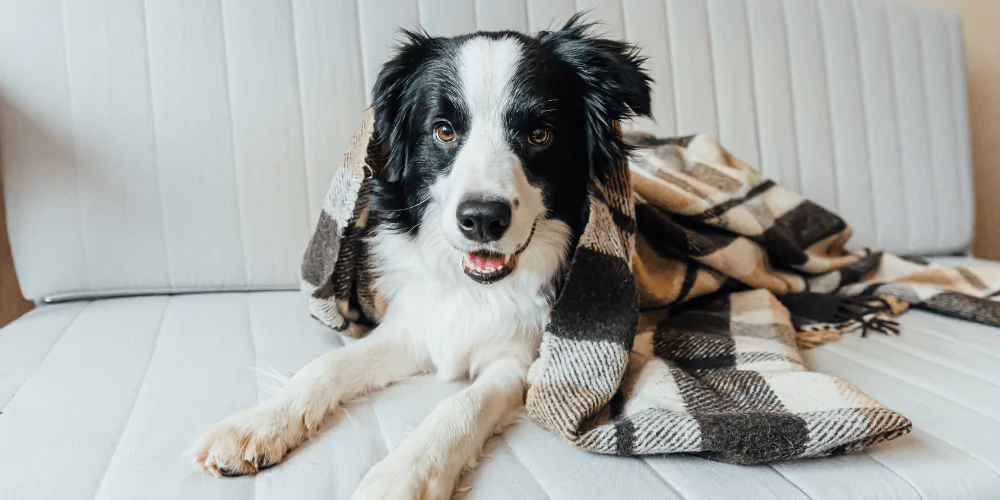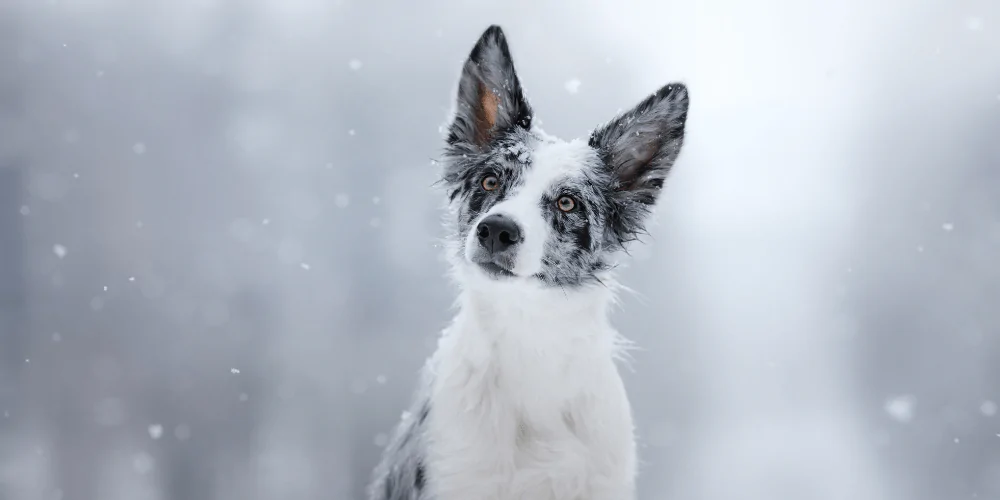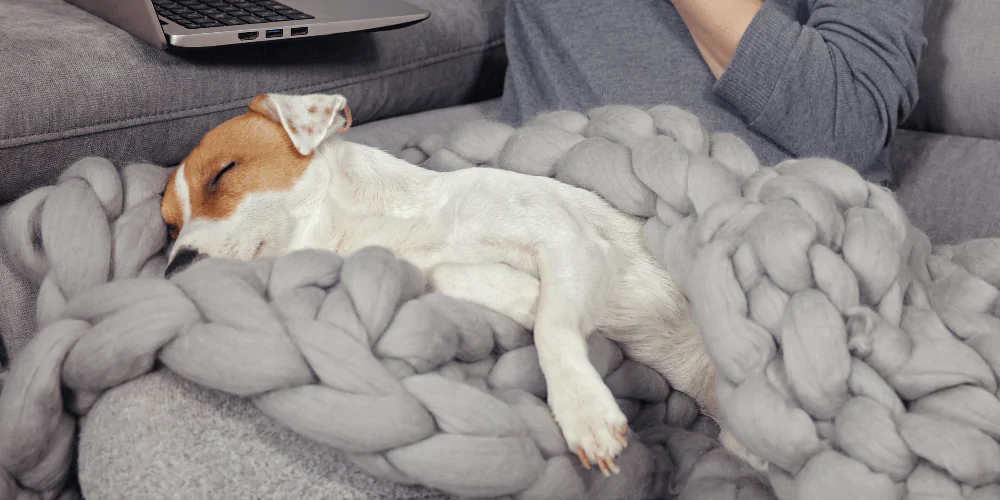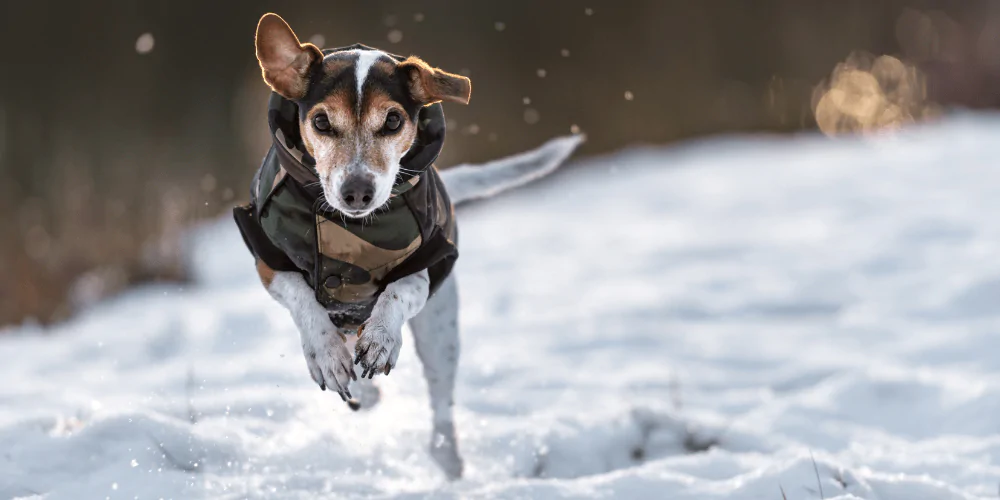
How to keep your dog safe and warm in cold weather

Dr Scott Miller
1 December 2023 | 6 minutes read
As the temperature drops and wintry conditions roll in, understanding how to keep your pup warm and cosy is an absolute must.
Expert vet Dr Scott Miller explains how cold weather can affect your dog and shares ways to look after them, both indoors and on walks.
- How to tell if your dog is cold
- Can dogs get sick from cold weather?
> Does cold weather affect arthritis in dogs?
> Can dogs vomit or get diarrhoea from cold weather? - How to keep dogs warm in winter
> How to keep a dog warm at night - Tips for walking dogs in cold weather
> What do I do if my dog won’t walk in the cold?

How to tell if your dog is cold
Dogs have a very similar response to being cold as we humans, so watch out for signs like:
- Cold body parts, such as the ears
- Shivering and trembling
- Acting lethargic
- Looking for places to warm themselves or take shelter

Can dogs get sick from cold weather?
Dogs can pick up a variety of health problems from those chilly temperatures, including:
- A weaker immune system – cold weather can affect your dog’s immune system, making it harder to fight off infections. Wounds may also not heal as quickly as normal.
- Gut issues – you may find that your pup struggles to digest things as easily as their gut slows down in the colder season. This can also affect how well the kidneys work.
- Increased weight gain – when it’s cooler, your dog burns more calories to keep warm, which can increase their appetite. But if they’re eating more and don’t exercise as much, there’s a chance they could gain weight.
- Hypothermia – if your dog gets too cold, their body temperature can drop to a dangerously low level. Signs of hypothermia include shivering and lethargy.
Hypothermia is a serious condition that needs immediate vet attention. Always speak to your vet if you’re worried that your dog has suffered from hypothermia. It can lead to illness or injury after they’ve warmed up.
> Does cold weather affect arthritis in dogs?
Take extra care of your arthritic pooch in winter. You may notice them being less active or showing signs of discomfort during this season.
That’s because cold weather aggravates symptoms of arthritis and can make your dog feel stiffer, slower, and more pain than usual.
> Can dogs vomit or get diarrhoea from cold weather?
Cold weather itself doesn’t directly cause vomiting and diarrhoea in dogs. But changes in diet as we enter the festive season, or stress from the cold, could upset their stomach and give them these symptoms.
If your dog is sick or keeps having loose stools, get in touch with your vet.

How to keep dogs warm in winter
Leaving the heating on all day isn’t feasible or affordable for many pet parents. So here’s some ideas for keeping your dog warm:
- Look for more budget-friendly ways to insulate your house. For example, adding door and window draft excluders or solar control window films.
- Dry your dog off anytime they come back in from a toilet break in the garden – cold bellies and paws don’t make for cosy pups.
- Leave plenty of blankets around for your pooch to snuggle up when they start to feel the cold setting in.
- Think about getting heat mats, microwavable toys, or hot water bottles for your pooch to snuggle with if they’re chilly.
> How to keep a dog warm at night
Here’s a few more ways you can help keep your pooch warm when nighttime rolls around:
- Check they’re fully dry from the day’s escapades as damp fur can make them feel more chilly.
- Find a warm and draft-free place for your dog to snooze, preferably elevated above any cold floors.
- Layer up your dog’s bed with extra blankets and towels for insulation or add a self-warming pet mat (if safe to do so).

Tips for walking dogs in cold weather
Walking your pet pal in cold weather doesn’t have to be a daunting task. You’ll just need to take extra care on your outdoor expeditions.
- Wrap them up in an insulated, waterproof dog coat. Be careful of dog boots as these can restrict their movement.
- Use a reflective dog collar, harness, or lead to make it easier for your dog to be seen during those darker times of the day.
- Keep your dog on a lead if they’re tempted to jump in ponds and lakes. Even if they look frozen over, you don’t know how safe they will be.
- Encourage lots of sniffing and try mixing up your route to keep the walk interesting for your pup.
- Be mindful of the time of day when you’re heading out. It’s coldest in the early morning and late evening, so try going for a walk when it’s warmer, such as midday.
- Steer clear of walking too close to cars in case there are traces of antifreeze around them, which is poisonous to dogs.
- Constantly check in with your pup and watch out for signs of discomfort or distress. That’s when it’s time to head home and warm up.
When you get home from your wintry walk:
- Carefully clean your dog’s paws, belly, and legs in case they’ve picked up any grit or chemicals on the way.
- Check for compacted snow between their toe pads which can turn icy and be very painful if left stuck in their paws.
- Make sure your pup is completely dry, taking extra time and care if they have long fur.
> What do I do if my dog won’t walk in the cold?
Some dogs won’t be comfortable going out for a long walk in chilly weather.
A nice warm jacket, some tasty treats, and healthy enthusiasm may encourage them out of the house. Remember, a short, brisk walk is always better than none at all.
If a good, long walk isn’t on the cards, give your pup plenty of enrichment at home to keep their brain engaged. For example:
- Hide treats or toys around the house for them to sniff out
- Give them a doggy puzzle to solve
- Stuff a Kong with dog-safe foods like natural peanut butter and let them lick it
- Do some basic cue training such as sit, stay, and lay down – all very handy when festive visitors start arriving!
Keep your dog protected throughout winter and beyond with flexible dog insurance from Petsure.


